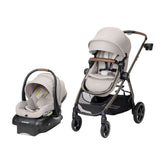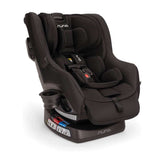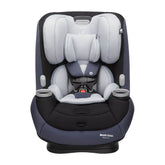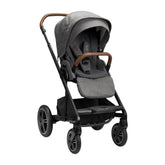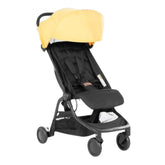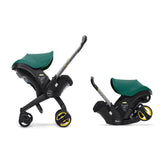It's Time! Smart Tips for How to Push Baby Out During Labor

Updated 7 Jan 2025
After the completion of your labor, you enter the second stage of childbirth, which involves pushing and delivering your baby. You're nearly finished, but getting across the finish line will require some effort. Until now, you haven't had much control over the progress of childbirth, but that is about to change. With the cervix fully dilated, it is time to actively assist your baby in navigating through the birth canal by pushing. Let’s take a closer look at a few tips for how to push during labor.
How to Know When You’re Ready to Push
During this stage, your contractions should become more regular compared to the transitional labor phase. They typically last about 60 to 90 seconds but occur at greater intervals, usually two to five minutes apart. The intensity of contractions may vary, with some being less intense and others potentially more intense. You should start noticing distinct breaks or rest periods between contractions, although it may still be challenging to identify the beginning of each contraction.
Common experiences during the second stage of labor (although sensations may be reduced or absent if you have received an epidural) include:
- Pain with contractions, although it may be less intense
- A strong urge to push, although not all women feel it, especially if they have had an epidural
- Pressure in the rectal area
- A surge of renewed energy or fatigue
- Noticeable contractions as your uterus visibly rises with each one
- Increased bloody show
- Sensations like tingling, stretching, burning, or stinging in the vaginal area as your baby's head emerges
- A slippery and wet feeling as your baby emerges.

How to Push During Labor
As this stage begins, you may experience a sense of relief knowing that you can finally start pushing. It's important to remember that it's completely normal to feel a range of emotions during this time, such as embarrassment, inhibition, fear, or even frustration, particularly if the process is taking longer than expected. Rest assured, it's time to focus and work together to safely deliver your baby.
During the pushing stage of labor, you will follow the instructions of your healthcare provider or birthing center staff. Typically, you will push three times with each contraction or as you feel the urge, resting for a contraction if needed. Here are some tips to consider:
- Push as if you're having a bowel movement, focusing on relaxing your body and thighs.
- Tuck your chin to your chest and maintain a focused gaze below your navel to direct your pushes effectively.
- Give it your all and put energy into your efforts to help your baby move through the birth canal faster.
- Stay focused and avoid frantic pushing or straining your upper body or face.
- Changing positions may be helpful if your baby isn't progressing during pushing.
- Trust your instincts and follow your urges to push, taking deep breaths and exerting force as you feel comfortable.
- Rest between contractions to conserve energy for the next round of pushing.
- Follow instructions from your healthcare provider, who may suggest pausing pushing for a few contractions or using alternative techniques, like panting or blowing.
- If a mirror is available, watching your baby's head crown can provide inspiration.
Remember, the healthcare team is experienced and understands the normal aspects of childbirth, so focus on following their guidance and trust in the process.

How to Push During Labor with an Epidural
Since an epidural anesthetizes the mother, it may limit her ability to assume various birthing positions which may hinder progress during labor. The extent of movement varies from mother to mother, with some women having more mobility than others. Regardless of these limitations, utilizing effective positions for pushing still requires substantial support from partners, doulas, labor nurses, and others. Some of these positions include:
- Kneeling at the foot of the bed and leaning over
- Semi-prone position
- Semi-sitting position with leg supports
- Side-lying position
- Supine position with stirrups or leg supports
- Supported squat position
The use of an epidural is unlikely to significantly affect your ability to push, although it may result in a longer pushing phase. However, many women willingly accept a slightly extended labor duration in exchange for the pain relief provided by the epidural.
How to Push During Labor Without Tearing
During childbirth, vaginal tears, also known as perineal lacerations or tears, can occur when the baby's head is passing through the vaginal opening. This can happen if the baby's head is too large for the vagina to stretch around or if the vagina doesn't easily stretch. Vaginal tears can vary in severity, ranging from affecting only the skin around the vagina to involving the anal sphincter (known as third- and fourth-degree tears). According to experts at the Mayo Clinic, there are certain measures you can take that may potentially reduce the risk of severe tears.
- Strive for more controlled and less expulsive pushing to allow your tissues time to stretch and give way for the baby. Gentle and gradual pushing can facilitate the baby's delivery.
- Keep the perineum warm by placing a warm cloth on it during the second stage of labor.
- Try using perineal massage ahead of time and during the second phase of labor to gently stretch the area.
- Delivering in an upright position (instead of lying flat on your back) may also reduce the likelihood of tearing.
In addition, research has demonstrated that proper breathing techniques, like blowing, can also help reduce perineal tears in laboring women. During intense contractions, laboring moms can practice a specific breathing pattern called the "pant-pant-blow" technique, performing about 6 cycles per minute. Here's how to breathe during labor pushing:
- As the contraction begins, take a deep breath in through your nose.
- Exhale using two short pants followed by one longer blow. It can be described as "hee-hee-hooooo."
- Focus on maintaining this breathing pattern for approximately 10 seconds.
- Repeat the pant-pant-blow breathing until the contraction subsides.
This technique helps you manage the intensity of the contractions and allows you to stay in control during labor. Remember to listen to your body and adjust the breathing pattern as needed to find what works best for you.

How Long Is Too Long to Push During Labor?
On average, the delivery stage of childbirth typically lasts between 30 minutes to an hour, but it can vary. First-time mothers may experience a longer duration, while subsequent deliveries tend to be quicker. In some cases, delivery can occur in just a few minutes.
Previously, a prolonged pushing phase during childbirth was defined as pushing for over a certain amount of time depending on various factors, such as whether it was a first-time delivery or not, and whether the mother had received an epidural. For example, it was considered prolonged if pushing lasted for more than 3 hours in first-time mothers with an epidural, over 2 hours in first-time mothers without an epidural, more than 2 hours in experienced mothers with an epidural, and exceeding 1 hour in experienced mothers without an epidural. However, updated guidelines from the American College of Obstetricians and Gynecologists now recommend allowing mothers more time to push. The revised guidelines suggest an additional hour for each category, giving mothers more flexibility in the pushing phase of labor.
Disclaimer: The information on our site is NOT medical advice for any specific person or condition. It is only meant as general information. If you have any medical questions or concerns about your child or yourself, please contact your healthcare provider.

